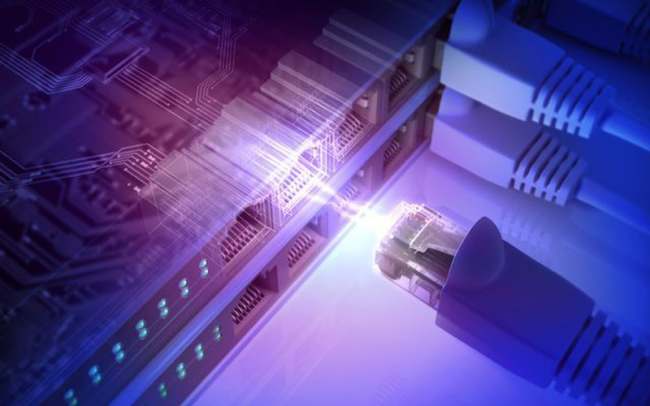Você sabe o que é Internet Protocol over Ethernet (IPoE)? Diante da popularização desse protocolo, é provável que sim. No entanto, se tem alguma dúvida a esse respeito, leia este post.
Aqui, apresentaremos não apenas o que é Internet Protocol over Ethernet, mas também como funciona e seus principais benefícios. Portanto, não deixe de conferir. Boa leitura!
O que é Internet Protocol over Ethernet (IPoE)?
O Internet Protocol over Ethernet, também conhecido pela sigla IPoE, é um protocolo que encaminha pacotes IP sobre redes de acesso ethernet. Em outras palavras, essa técnica encapsula datagramas IP em quadros de ethernet, baseado na especificação RFC 894.
Vale dizer que este protocolo depende necessariamente, em casos práticos, do Dynamic Host Configuration Protocol (DHCP), o que pode ser uma limitação em alguns casos. Assim, uma alternativa seria usar o PPPoE. A sigla se refere a Point-to-Point Protocol over Ethernet, ou Protocolo Ponto-a-Ponto via Ethernet, em português.
Aliás, confira uma análise que fizemos em nosso Blog sobre conexão DCHP ou PPPoE: onde usar cada uma.
O IPoE é uma técnica comum, talvez a mais utilizada no Brasil, que normalmente é empregada para estabelecer uma conexão entre servidores distantes. No entanto, ela é estabelecida em uma conexão ethernet, que não oferece suporte ao processo de autenticação de usuários.
Ela opera com uma espécie de conexão ponto a ponto. Por isso, caso ocorram erros nesse protocolo, a rede pode sofrer com problemas de acesso ou até mesmo perder completamente o acesso à Internet.
Como funciona o Internet Protocol over Ethernet?
Podemos explicar o funcionamento do Internet Protocol over Ethernet a partir de alguns passos simples. Veja:
Passo 1: Identificação do assinante
Em primeiro lugar, o IPoE é um protocolo que necessita de credenciais para estabelecer uma conexão. Assim, ele não exige qualquer identificação do assinante, visto que esta é feita por meio do endereço de IP.
Passo 2: Autenticação do assinante
Como dissemos, o IPoE não possui a função de login para que seu assinante possa acessar o sistema/tecnologia. No entanto, faz uso da conexão física para que o assinante consiga verificar os serviços disponíveis, tais quais portas e VLAN, entre outros.
Passo 3: Endereço IPoE
Na terceira etapa, o usuário do protocolo IPoE aceita uma mensagem de solicitação DHCP de broadcast, a qual é enviada pelos servidores. Após o aceite da mensagem, o DHCP confirma a atribuição do endereço IPoE.
Tal processo, vale dizer, pode ser alterado caso o servidor DHCP esteja localizado em outra rede.
Passo 4: controle e/ou monitoramento/renovação de IPoE
O processo de renovação e monitoramento no IPoE é alimentado pela capacidade do servidor DHCP de ser utilizado como mecanismo de manutenção da atividade.
Vantagens e desvantagens do IPoE

Como todo protocolo ou técnica, há vantagens e desvantagens que valem a pena conhecer para que se possa tomar uma decisão segura. Tendo isso em mente, elaboramos este tópico para apresentar as principais. Veja:
Vantagens
Simplicidade
Uma das principais vantagens do IPoE é a sua simplicidade, ou melhor, sua facilidade em relação à sua implementação. Como podemos ver, é super fácil aplicar essa tecnologia em uma empresa com o uso de um servidor DHCP.
Suporta transmissão multicast
Ainda podemos dizer que se trata de uma estratégia que é capaz de suportar transmissão multicast.
Para quem ainda não sabe, multicast é um método ou técnica que pode ser utilizada para transmitir um pacote de dados para diversos destinos, de modo simultâneo. Desta maneira, em uma transmissão multicast, o transmissor envia o pacote de dados somente uma vez, cabendo aos receptores captarem a transmissão e reproduzi-la.
Uma das principais vantagens da transmissão multicast está justamente na economia de banda larga para enviar dados ou trocar dados entre um servidor e seus clientes. Assim, a empresa pode economizar ao utilizar o protocolo IPoE.
Eficiência e custo-benefício
O IPoE tem como uma de suas vantagens consumir menos recursos no equipamento e oferecer uma melhor comunicação Multicast na rede.
No entanto, ainda assim é imprescindível submeter a rede a uma detalhada análise antes da aplicação deste protocolo, visto que ele também apresenta algumas desvantagens, como você verá a seguir.
Desvantagens
Como uma moeda, há sempre um lado que deve também ser visto para que o gestor de TI tome uma decisão sólida e correta. Em relação às desvantagens, podemos destacar algumas:
Dependência do DHCP
O uso de IPoE é uma técnica que depende necessariamente da tecnologia DHCP para uma operação de grande escala. Desta maneira, isso pode ser visto como um problema, pois caso ocorra algum tipo de incidente, o protocolo IPoE pode ser comprometido.
PPPoE x IPoE
Embora o texto em questão tenha como principal objetivo fornecer informações acerca do protocolo IPoE, vale a pena conhecê-lo tendo como parâmetro o protocolo PPPoE.
Então, para isso, listamos a seguir algumas funções apresentadas por ambos os protocolos e o desempenho de cada um em relação a tais funções.
Praticidade
Neste quesito, o IPoE sai na frente. Diferentemente do PPPoE, ele dispensa o uso de softwares para fazer a discagem do cliente. Ele é capaz de realizar a autenticação dos usuários a partir da localização física (que pode ser aferida por meio de um ID de VLAN / PVC ID exclusivo).
Assim, com sua utilização, não são requeridos login e senha para que os usuários acessem a Internet.
Software de discagem
Ambos os protocolos também se diferenciam em relação a esse ponto. Enquanto o PPPoE exige um software de discagem para que possa funcionar adequadamente, o IPoE dispensa tal tecnologia, o que o torna super simples.
Aliás, muitos dos seus assinantes podem enfrentar dificuldades como as quedas e reconexões constantes de clientes com PPPoE por conta dos firmwares originais dos fabricantes. Esse mau desempenho e instabilidade, que afetam a experiência do seu cliente, podem ser facilmente resolvidos com a nossa solução Flashbox. Quer saber como?
Muito simples. Com a nossa firmware Flashbox instalada em seu cliente, você terá total controle sobre a conexão e evitará essas quedas e reconexões por conta do PPPoE.
Cada cliente apresenta uma necessidade distinta
Diante do que foi apresentado, podemos entender melhor o que é IPoE e como essa solução funciona. Também vimos que, em alguns pontos, é uma técnica que se destaca em comparação com o PPPoE.
No entanto, cada empresa apresenta diferentes desafios em termos de necessidades de rede, equipamentos e infraestrutura. Por isso, a escolha da melhor solução deve sempre ser feita caso a caso, considerando as necessidades específicas do negócio.




Deixar um comentário